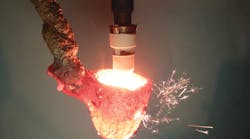SinterCast AB reported it has reached a record level of new installations for the third consecutive year, thanks to a new commitment for a System 3000 Plus package. The latest order will be completed in December for a foundry producing CGI cylinder blocks in high-volume series.
"New installation activity is the strongest indicator of future CGI series production commitments and overall market growth," stated Dr. Steve Dawson, president & CEO of SinterCast. "Three consecutive years of record installations, with increased footprint in Europe, Asia, and the Americas, clearly shows SinterCast's leadership position, the market acceptance of CGI, and the demand for stronger materials."
Stockholm-based SinterCast did not identify the foundry that placed the order, but it noted the operation would start producing the engine blocks in January.
CGI, or compacted graphite iron, is a lightweight alternative to gray iron and aluminum for automotive component manufacturing. Stockholm-based SinterCast is the largest supplier of process control technology for producing CGI. The technology, now in its third generation, is under license to numerous automotive foundries worldwide and used to cast more than 50 different components in series production.
The System 3000 Plus package controls the base treatment of CGI metal, automatically; process control measurement; and performs the final adjustment of magnesium and inoculant prior to casting. Data collected by the System 3000 Plus, and the melting and molding operations, is maintained for process control and traceability.
The new order represents the third full System 3000 installation commitment during 2013. Combined with two Mini-System 3000 installations and the installation of one automatic base treatment station to upgrade an existing System 3000 installation to the full System 3000 Plus capability, the new order marks the sixth installation of the year, and surpasses the previous installation revenue record set in 2012. Further installation discussions are ongoing, providing opportunities for additional installation commitments and revenue before year-end, the developer noted.









